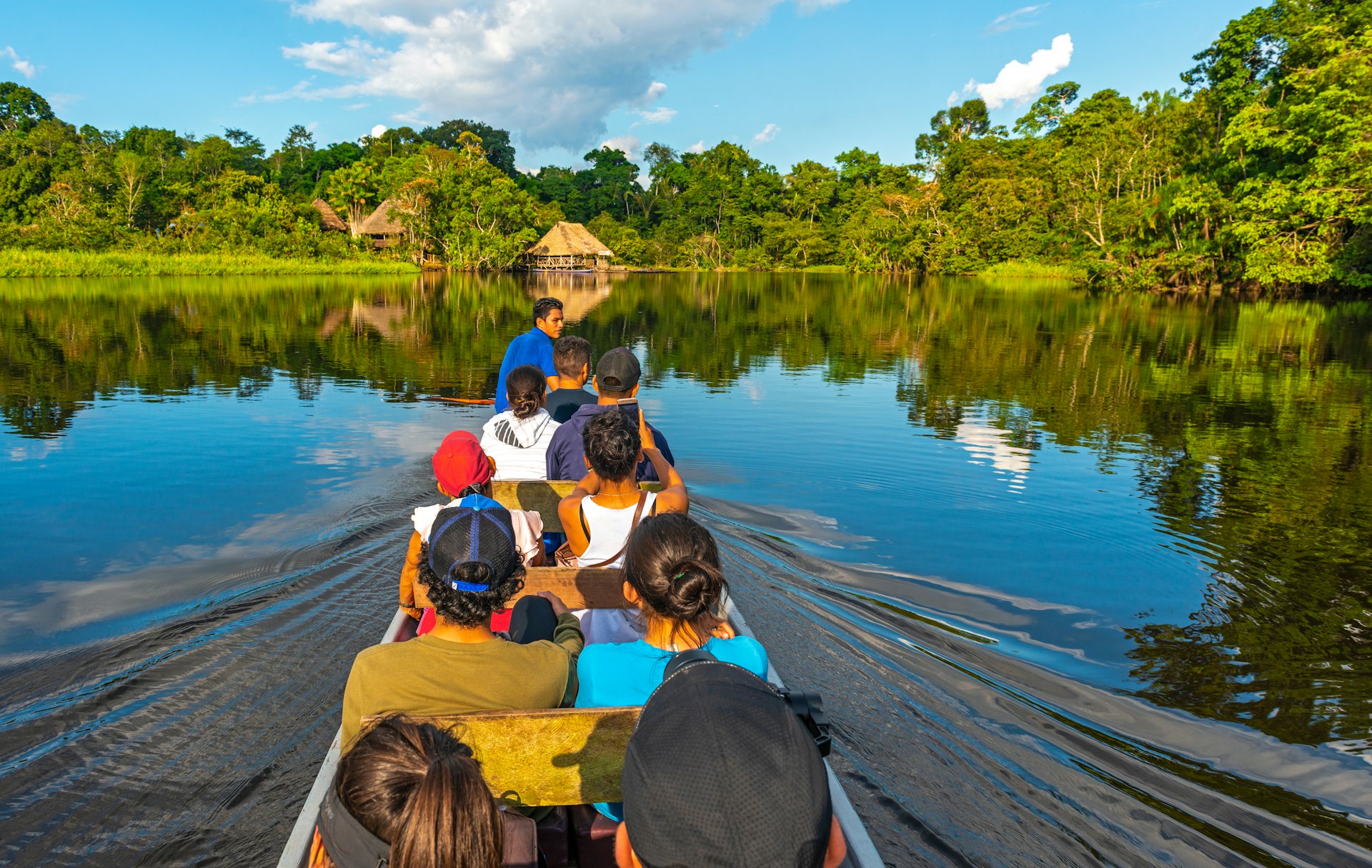In Lonely Plan-It, we take you step by step through how we put together some of the most complicated travel adventures – so you can recreate them yourself with ease. Here, Bailey Freeman shares the steps to planning an incredible adventure to the Ecuadorian Amazon.
Despite its small size, Ecuador is one of the most biodiverse places on the entire planet – and a visit to its Amazon region is the feather in the cap of any person who wants to see the natural world at its most astonishing.
I visited the Ecuadorian Amazon – also known in-country as the Oriente – for my work as a travel writer and was pleasantly surprised how accessible the region was for travelers. Still, there are still several things to keep in mind as you plan your trip.
Here’s our guide to planning the perfect visit to the Ecuadorian Amazon, an incredible place of cultural and environmental beauty.
Step 1: Decide what activity you want to do
Plan your route around what interests you the most.
The Amazon is home to a wealth of adventure: white-water rafting, wildlife watching, forest walks and more. It’s best to decide on your main priorities prior to your arrival, as different access points offer different experiences.
If you’d like to marvel at the biodiversity of Ecuador’s famous Parque Nacional Yasuní, the town of Coca will be your starting point. Want to go rafting on tributaries to the mighty Amazon River? Start in Tena or Macas instead. Visiting the hot springs at Baños and want to tack on some Amazon adventure? Puyo would be a good place to put on your radar.

Step 2: Choose a home base
Whether you choose a jungle lodge or a hostel, adventure awaits.
Accessing the edge of the Amazon in Ecuador is pretty easy, as roads are well maintained and Amazon travel hub towns aren’t too far from Quito. But things get a bit more complicated once you start to head deeper into the forest. If you’re looking for convenience, we recommend choosing a jungle lodge that can serve as an all-in-one adventure coordinator. These atmospheric hotels offer transport to their location, meals and tours, often specializing in experiences unique to their region of forest. For example, I crashed at the Cabañas San Isidro, a launchpad hugely popular with birders. Other great options are Achuar-owned Kapawi Lodge and the Añangu-owned Napo Wildlife Center Ecolodge.
If you don’t have the budget for a full lodge experience, don’t worry: you can opt for a wallet-friendly hostel or hotel in towns like Tena and Coca and book individual operators offering experiences à la carte. You’ll have to plan a few more logistics yourself, but you’ll still get to experience the majesty of the Amazon.

Step 3: Pick the right time of year to go
Find what works best for you, but expect some rain.
Due to its location along the equator, Ecuador doesn’t really experience substantial swings in weather with the seasons. That said, some months in the rainforest are wetter than others, so it doesn’t hurt to look at the calendar before you hit the road.
The Amazon experiences a rainy season February through September. While the sogginess may put off some travelers, more rain means better waterway navigability, more spottings of water-loving creatures and cooler temperatures. The cons? The potential for washed-out trails and more mosquitos. The term “dry season” is relative as rain is still common – yet the period from October through January does provide some relief from the moisture (and mosquitos), more access to hiking paths and warmer temperatures.
Step 4: Pack smart
You’ll need proper gear for exploring this region.
In brief: pack for sun, rain and lots of bugs. In addition to staples like good (waterproof) hiking boots, water/adventure sandals and bug spray, we also recommend breathable long-sleeve shirts and long pants: you may be a bit hot, but it’s better than being a walking buffet for biting bugs. You’re going to want to protect your belongings from rain and a potential tumble into the Amazon’s rivers, so a dry bag for electronics or a waterproof daypack will come in extremely handy. Finally – and we can’t emphasize this enough – slather on the sunscreen. Ecuador sits at the equator, the part of the Earth that receives the most intense sun exposure, so those who are prone to sunburning will need to apply hourly. Pick an eco-safe and water-resistant option.
Step 5: Be respectful
There are many ways to help protect this incredible place.
The Amazon is one of our planet’s biggest treasures, so visiting with respect is absolutely essential. On the environmental side, make sure you pack out any and all trash, and opt for eco-safe bug spray and sunscreen options. While on your nature walks, remember to look around for – but never touch – all the incredible plants and animals you’ll encounter.
The Amazon is also home to thousands of Indigenous communities, some of which work with tourism projects throughout the region. When you visit, they are your hosts. While every group is different and we can’t speak for them, here are a few general guidelines. Don’t take pictures of anyone unless permission is given to do so, especially children. Be kind and respectful about the elements of their culture they share with you, and be sure to support their communities in the ways they request (in particular, don’t bring “‘donations” like toys or toiletries unless specifically asked to).
If I could do it all again…
I’d slow down. While it’s tempting to hop from activity to activity, half the magic is spending time in such a storied and ecologically essential place. Include some time for unhurried wanderings or hammock naps. You won’t regret it.
